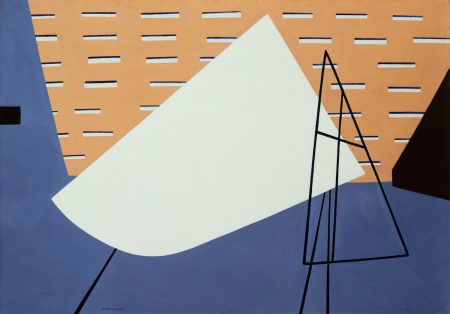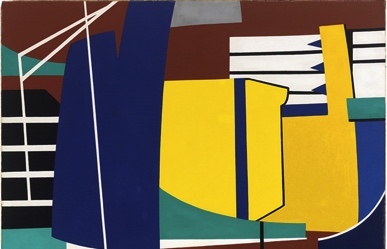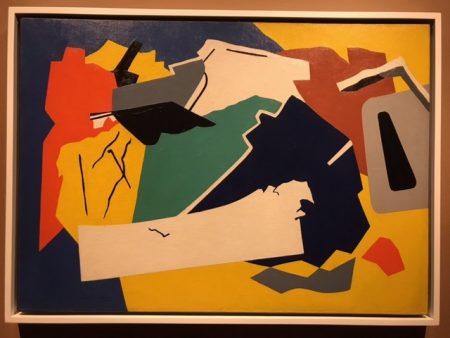The aero-dynamic legacy of Dayton, Ohio is the backdrop of the current exhibition at the Dayton Art Institute documenting the career and art of artist/illustrator Ralston Crawford, Entitled Air + Space + War, the exhibition divides this documentation into three areas of focus: Crawford’s photography and aviation background, the development of visual spacial language and cartographic design and his war deployment as a commissioned observer of the effects of airplane technology and the destruction of war.
Air war support and bombing strategies were a major component in the WWII Ally arsenal in all theaters, even as the equipment and tactics were being developed in real time. Ralston Crawford enlisted in the Air Force and served in the weather division, being commissioned to observe and photograph aerial views from reconnaissance planes.
Crawford’s writings document his flights in a variety of air craft including B-25, C-54,Piper Cubs, seaplanes and weather reconnaissance planes. Crawford’s compositions, derived from his photography while aloft, often included fractional glimpses of the plane wing or other structure, highlighting the machine’s role in shifting his perspective.
Crawford’s writings document the aerial episodes he experienced, the planes he flew in and the impact that his observations of air warfare made on him personally. His writings also describe his sensory reactions to the compression of space and time through air travel.
Crawford executed commissioned artwork for the use of the armed forces in a variety of media from his air experiences and the photographs he made.

In 1945, Crawford was sent to the Curtiss-Wright Aircraft Plant to plan the Burton Tremaine commission. Pencil sketches from photographs included plane parts and the assembly process in the plant environment. Aircraft Plant was the first oil painting that Crawford produced. From several studies, he refined the composition from images bursting with plane parts and factory fixtures to the leaner composition that focuses on three main elements: the skip lighting pattern in the ceiling, a single airplane wing and the rhythmic echo of an abstracted ladder. Also notable is the the muted color palette of this early work from the Cincinnati Art Museum collection.

Oil on canvas, 30 x 36 in.
Mead Art Museum, Amherst College, 1996.10

Pen and ink on paper, 7 3/16 x 7 5/16 in.
Mead Art Museum, Amherst College, 1996.166
Nacelles are the aerodynamically shaped coverings that protect a plane’s engines. Crawford produced a high contrast pen and ink drawing in a vertical format analyzing the more modeled 3D forms taken from the photographs. Crawford flattened the shapes, turning them into expanses of solid color, stacked up in the foreground. The oil painting Nacelles expanded the composition in a horizontal format. Strikingly brilliant blue and yellows animate the nacelles shapes against background shapes in fresh green and burnt siena. The brilliance of this color palette is a startling new direction contrasting sharply with the greyed palette of Aircraft Plant.
On June 23, 1946, shortly before being sent to witness the atomic bomb run at Bikini Atoll known as Test Able, Crawford wrote to his dealer Edith Halpert: “The beauty of these atolls, from the air, is verbally indescribable, but I know that I can say something about them in paint.” Crawford’s composition is an areal view of the atolls, looking out over the wing of a plane. Straight structural lines of the craft’s wing contrast with the organic white lines carved in the deep blue water suggesting the atolls as seen from the plane.

Screenprint, 17 ¼ x 23 3/8 in.
Collection of John Crawford
Assigned to witness the practice run for Test Able, the artist produced several works for the armed forces about the result of the bombing run. The target ship, U.S.S. Nevada, was painted brilliant orange to increase visibility. These pieces present an excellent example of the range of Crawford’s processes, from photography to drawing and screen print to oil painting, refining the twisted shape relationships while editing out realistic details such as bolt and rivet patterns and joins. Crawford’s commission aided in the analysis of air bombing techniques and projected attack pattern strategies.
Later, he wrote again to Edit Halpert of the events he witnessed on Bikini Atoll:
Some aspects were for me of a quite beautiful nature—in a positive way; others were of quite a horrifying nature. One cannot express in paint the meaning of the bomb. After all it takes the collective intelligence of numerous physicists to detonate one of them. These pictures constitute my comment on the spectacle: the beautiful parts of the sequence (i.e., the positive and constructive), and the negative (destructive). Some the pictures are almost completely in one category, some in the other. Some, perhaps all, contain in a measure both elements.

Oil on canvas, 24 x 34 in.
Vilcek Collection
Growing out of the experimental bombing tactics came the realization that analysis of wind and weather patterns was essential to bomb-run strategies and destruction success stats. Crawford’s final weather service contribution is his inventive symbolism of meteorological phenomena. Hand drawn overlays with ink and airbrush diagramed the information relied on for timing and strategic analysis. Crawford’s pieces were published as war-update cover designs with Impact: an armed forces journal and Fortune Magazine, a popular edition for general public consumption.

about 1943-45
Collection of John Crawford
For many years following, the barbed linear descriptions of front movements, arrow patterns of wind direction and stylized cloud formations, were utilized for meteorological description with universality in televised forecasts, before the ubiquitous computer-generated radar shapes that crawl across regional maps like giant color-coded amoeba seen today.
Crawford’s service production became his identifiable expression in the decades following service. Indeed, he revisited the visual language of his service commissions for three decades, further expanding his lifetime oeuvre. The comprehensive Crawford exhibition would not have been possible without the support of his son John, whose personal archives comprise a great deal of the presented materials along side paintings from several art collections. Crawford’s art, derived from physical observation and photography, explained science, facilitated analysis and assisted the formulation of tactical strategies that were highly relevant to the Armed Forces.
–Marlene Steele, Painter
Exhibition continues at Dayton Art Institute through January 23rd, 2022.